TimTaiLieu.vn - Tài liệu, ebook, giáo trình, đồ án, luận văn
TimTaiLieu.vn - Thư viện tài liệu, ebook, đồ án, luận văn, tiểu luận, giáo trình các lĩnh vực CNTT, Ngoại ngữ, Luật, Kinh doanh, Tài chính, Khoa học...

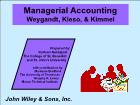 Bài giảng Managerial Accounting - Chapter 7: Budgetary Control and Responsibility Accounting
Bài giảng Managerial Accounting - Chapter 7: Budgetary Control and Responsibility AccountingAfter studying this chapter, you should be able to: 1 Describe the concept of budgetary control. 2 Evaluate the usefulness of static budget reports. 3 Explain the development of flexible budgets and the usefulness of flexible budget reports. 4 Describe the concept of responsibility accounting.
 62 trang | Chia sẻ: nguyenlinh90 | Ngày: 18/07/2019 | Lượt xem: 896 | Lượt tải: 0
62 trang | Chia sẻ: nguyenlinh90 | Ngày: 18/07/2019 | Lượt xem: 896 | Lượt tải: 0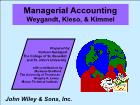 Bài giảng Managerial Accounting - Chapter 6: Budgetary Planning
Bài giảng Managerial Accounting - Chapter 6: Budgetary PlanningAfter studying this chapter, you should be able to: 1 Indicate the benefits of budgeting. 2 State the essentials of effective budgeting. 3 Identify the budgets the comprise the master budget. 4 Describe the sources for preparing the budgeted income statement. 5 Explain the principal sections of a cash budget. 6 Indicate the applicability of b...
 53 trang | Chia sẻ: nguyenlinh90 | Ngày: 18/07/2019 | Lượt xem: 973 | Lượt tải: 0
53 trang | Chia sẻ: nguyenlinh90 | Ngày: 18/07/2019 | Lượt xem: 973 | Lượt tải: 0 Bài giảng Managerial Accounting - Chapter 5: Cost-Volume-Profit Relationships
Bài giảng Managerial Accounting - Chapter 5: Cost-Volume-Profit RelationshipsAfter studying this chapter, you should be able to: 1 Distinguish between variable and fixed costs. 2 Explain the meaning and importance of the relevant range. 3 Explain the concept of mixed costs. 4 State the five components of cost-volume-profit analysis. 5 Indicate the meaning of contribution margin and the ways it may be expressed.
 74 trang | Chia sẻ: nguyenlinh90 | Ngày: 18/07/2019 | Lượt xem: 906 | Lượt tải: 0
74 trang | Chia sẻ: nguyenlinh90 | Ngày: 18/07/2019 | Lượt xem: 906 | Lượt tải: 0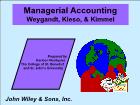 Bài giảng Managerial Accounting - Chapter 4: Activity-Based Costing
Bài giảng Managerial Accounting - Chapter 4: Activity-Based CostingAfter studying this chapter, you should be able to: 1 Recognize the difference between traditional costing and activity-based costing. 2 Identify the steps in the development of an activity-based costing system. 3 Identify the activity cost pools used in activity-based costing. 4 Identify and use the activity cost drivers in activity-based cost...
 62 trang | Chia sẻ: nguyenlinh90 | Ngày: 18/07/2019 | Lượt xem: 1046 | Lượt tải: 0
62 trang | Chia sẻ: nguyenlinh90 | Ngày: 18/07/2019 | Lượt xem: 1046 | Lượt tải: 0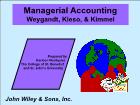 Bài giảng Managerial Accounting - Chapter 3: Process Cost Accounting
Bài giảng Managerial Accounting - Chapter 3: Process Cost AccountingAfter studying this chapter, you should be able to: 1 Understand who uses process systems. 2 Explain the similarities and differences between job order cost and process cost systems. 3 Explain the flow of costs in a process cost system. 4 Make the journal entries to assign manufacturing costs in a process cost system.
 61 trang | Chia sẻ: nguyenlinh90 | Ngày: 18/07/2019 | Lượt xem: 914 | Lượt tải: 0
61 trang | Chia sẻ: nguyenlinh90 | Ngày: 18/07/2019 | Lượt xem: 914 | Lượt tải: 0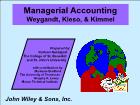 Bài giảng Managerial Accounting - Chapter 2: Job Order Cost Accounting
Bài giảng Managerial Accounting - Chapter 2: Job Order Cost AccountingAfter studying this chapter, you should be able to: 1 Explain the characteristics and purposes of cost accounting. 2 Describe the flow of costs in a job order cost accounting system. 3 Explain the nature and importance of a job cost sheet. 4 Indicate how the predetermined overhead rate is determined and used.
 58 trang | Chia sẻ: nguyenlinh90 | Ngày: 18/07/2019 | Lượt xem: 870 | Lượt tải: 0
58 trang | Chia sẻ: nguyenlinh90 | Ngày: 18/07/2019 | Lượt xem: 870 | Lượt tải: 0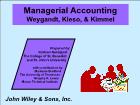 Bài giảng Managerial Accounting - Chapter 1: Managerial Accounting
Bài giảng Managerial Accounting - Chapter 1: Managerial AccountingAfter studying this chapter, you should be able to: 1 Explain the distinguishing features of managerial accounting. 2 Identify the three broad functions of management. 3 Define the three classes of manufacturing costs. 4 Distinguish between product and period costs. 5 Explain the difference between a merchandising and a manufacturing income st...
 58 trang | Chia sẻ: nguyenlinh90 | Ngày: 18/07/2019 | Lượt xem: 1221 | Lượt tải: 0
58 trang | Chia sẻ: nguyenlinh90 | Ngày: 18/07/2019 | Lượt xem: 1221 | Lượt tải: 0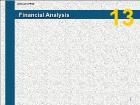 Bài giảng Financial Accounting - Chapter 13: Financial Analysis
Bài giảng Financial Accounting - Chapter 13: Financial AnalysisSustainable Income is best use of past data to forecast profitability. is the ability to generate future profits. comes from recurring items such as: - net income from operations - recurring non-operating items (such as investment income or interest expense) GAAP Rule: Statements must separate out non-recurring irregular items.
 24 trang | Chia sẻ: nguyenlinh90 | Ngày: 18/07/2019 | Lượt xem: 865 | Lượt tải: 0
24 trang | Chia sẻ: nguyenlinh90 | Ngày: 18/07/2019 | Lượt xem: 865 | Lượt tải: 0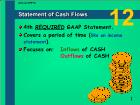 Bài giảng Financial Accounting - Chapter 12: Statement of Cash Flows
Bài giảng Financial Accounting - Chapter 12: Statement of Cash FlowsGAAP Rule: If a company trades or borrows in an investing or financing activity but doesn’t use only cash, report these activities in either a separate schedule at the bottom of the statement of cash flows or in the footnotes to the financial statements.
 30 trang | Chia sẻ: nguyenlinh90 | Ngày: 18/07/2019 | Lượt xem: 905 | Lượt tải: 0
30 trang | Chia sẻ: nguyenlinh90 | Ngày: 18/07/2019 | Lượt xem: 905 | Lượt tải: 0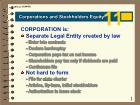 Bài giảng Financial Accounting - Chapter 11: Corporations and Stockholders Equity
Bài giảng Financial Accounting - Chapter 11: Corporations and Stockholders EquityCORPORATION is: Separate Legal Entity created by law - Enter into contracts - Declare bankruptcy - Corporation pays tax on net income - Shareholders pay tax only if dividends are paid - Continuous life Not hard to form - File for state charter - Articles, By-laws, Initial stockholders - Authorization to issue stock
 25 trang | Chia sẻ: nguyenlinh90 | Ngày: 18/07/2019 | Lượt xem: 800 | Lượt tải: 0
25 trang | Chia sẻ: nguyenlinh90 | Ngày: 18/07/2019 | Lượt xem: 800 | Lượt tải: 0
Website đang trong thời gian thử nghiệm, chờ xin giấy phép của Bộ TT & TT.

